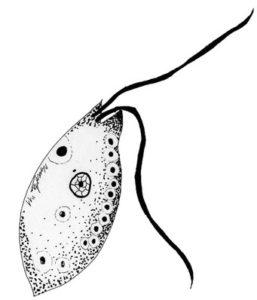

The discovery of Mimivirus in a French cooling tower amazed virologists and changed our view of the biology and evolution of giant viruses. Since then, many other giant viruses have been identified, and with three exceptions, they all appear to infect species of Acanthamoeba. Now a new member of the Mimivirus family has been discovered that infects the flagellated eukaryote Bodo saltans (pictured: image credit).
Bodo saltans virus (BsV) was isolated from freshwater collected from a pond in British Columbia. It infects the eukaryote Bodo saltans, a kinetoplastid, so named because these organisms contain a single large mitochondrion with a genome consisting of many circles of DNA linked together like chain mail. Other kinetoplastids are pathogenic parasites, such as Leishmania and Trypanosoma.
BsV virus particles resemble those of Mimiviruses, and they similarly replicate in cytoplasmic factories. The BsV genome is a 1,385,869 base pair linear double-stranded DNA. It encodes 1227 predicted open reading frames, of which 27% encode proteins that match known eukaryotic sequences, while over half are not recognizable. The genome encodes proteins involved in DNA replication and repair, RNA synthesis and modification, translation proteins, and capsid proteins. Here are some of the unique features of the BsV genome:
- There are no genes for tRNAs – different from all known giant viruses. The kinetoplastid host carries out extensive RNA editing – addition of bases that are not templated by DNA. As BsV does not encode enzymes involved in this process, the virus must use host tRNAs in the process of protein synthesis.
- Genes encoding a membrane fusion system might have been acquired from the eukaryotic host by horizontal gene transfer. This system could be involved in virus entry into the cytoplasm.
- There are ample mobile genetic elements present, including self splicing proteins (called inteins) and sequences known as ribozymes that can splice themselves out of an RNA. These mobile genetic elements are not found in the genomes of other giant viruses, although those genomes do have their own ‘mobilome’. The BsV mobilome might be involved in competition with related viruses, by inactivating essential genes.
- There are 148 copies of a gene encoding a protein that might be involved in antagonizing host defenses. The authors believe that one copy of this gene was duplicated repeatedly as more of the encoded protein was needed to replicate in host cells. A similar expansion of genes encoding an antagonist of a host innate immune protein has been observed in the genome of vaccinia virus (discussed on TWiV #198).
It is proposed that BsV is a member of the Mimiviridae subfamily Aquavirinae. While BsV was isolated from fresh water, the finding of abundant related genome sequences in oceanic datasets suggests that they are part of the largest group of giant viruses in the seas.

Pingback: Bodo saltans virus, an abundant giant aquatic Mimivirus - VETMEDICS
Pingback: Bodo saltans virus, an abundant giant aquatic Mimivirus - Virology